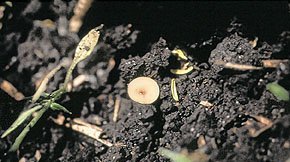Sclerotinia In Canola
Sclerotinia stem rot is the most serious disease of canola in the Prairies. Losses ranging from 5-100% have been reported for individual fields. On average, yield losses equal 0.4 to 0.5 times the percentage infection.


Host Crops
Canola, sunflowers, dry beans, field peas, lentils, mustard, potatoes
Biology
The severity of sclerotinia in canola is variable. It is dependent on the time of infection and climatic conditions. The disease is favoured by cool temperatures and prolonged periods of precipitation.
Sclerotinia survives in the soil for up to 4 years as irregular-shaped fungal bodies, called sclerotia. The sclerotia germinate in the summer, producing mushroom-like structures. These release wind-borne spores that travel up to 1 km. The disease is favoured by moist soil conditions (at least 10 days at or near field capacity) and temperatures of 15-25 degrees C (60-75 degrees F), prior to and during canola flowering. The spores cannot infect leaves and stems directly. They must first land on flowers, fallen petals, and pollen on the stems and leaves. These provide the food necessary for the spores to germinate, grow, and infect the canola plant.
The symptoms usually develop several weeks after flowering begins. The plants develop pale-grey to white lesions, at or above the soil line and on upper branches and pods. The infections often develop where the leaf and the stem join because the infected petals lodge there. Infected stems appear bleached and tend to shred. Hard black fungal bodies, of varying sizes, develop within the infected stems, branches, or pods. Plants with girdled stems wilt and ripen prematurely.
Symptoms Of Damage
The symptoms include premature ripening and pale-grey or white lesions on stems, branches and pods. Sclerotia form within the stems, branches and pods. Severely infected crops frequently lodge, shatter at swathing, and make swathing more time consuming.
Scouting Techniques
If the field has a previous history of sclerotinia and weather conditions have been wet several weeks prior to canola flowering, scout the field for small mushrooms at the early blossom stage. After flowering look for prematurely- ripened plants. Infections begin as a soft rot that girdles the stem. The lesions turn white, become brittle, and tend to shred.
Economic Thresholds
Petal test kits and in-field diagnostic kits are commercially available. These enable a grower to determine the cost effectiveness of sclerotinia control. A sclerotinia stem rot checklist can also assist in predicting stem rot disease levels. The checklist considers yield potential, previous disease presence and current weather conditions. Ask your agricultural representative for a copy of the checklist. The checklist will provide some direction in making a decision on whether or not to use a fungicide.
Control Tips
- All canola varieties are susceptible to sclerotinia. Polish varieties have lighter canopies and seem to have much lower infection levels. Use seed that is free from sclerotia.
- A minimum of a 4-year rotation between susceptible crops is recommended although rotation alone will not prevent infection. Sclerotinia also attacks pulse crops, sunflowers, mustard, sweet clover, and potatoes. This limits the crops that can be used in a rotation to manage the disease.
- Fungicide must be applied before symptoms of stem rot are visible, at the 20-30% bloom stage of the crop. Do not apply fungicide if the stem rot infection is already evident since it is too late to have any effect. Check the provincial Guide To Crop Protection for guidelines on the timing of specific fungicides.
For further information, contact your GO representative.

